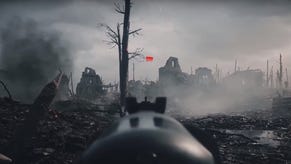Battlefield 1: here's how Bullet Drop and Critical Hits have changed sniping
Those who prefer to play a sniper in Battlefield games should know the role will change a bit when Battlefield 1 launches.
Our resident Battlefield expert Westie is rather fond of playing a sniper, and in the video above he provides information on what stays the same and what is changing in Battlefield 1.
The video starts off with a look at the menu, and focuses on the statistics shown for the player's rifle on the right hand side. There is also an overview of starting ammunition, fire mode, rate of fire and a chart.
This particular chart for the Sniper shows damage over distance via Damage Drop and Bullet Drop.
The former is part of the game's new Critical Hit mechanic. When the line in the bar is higher, the player will do more damage with their weapon - and outside of that, only standard damage will apply. This will put a much greater emphasis on rifle choice: some may have a critical hit with a longer range while others make better use of close quarters impact. Players will find themselves switching out weapons depending on either the map or the situation due to this new mechanic.
Moving along, the Bullet Drop applies to the bullet as it flies and how gravity pulls it down. Battlefield players will be familiar with this mechanic, but in Battlefield 1 the value changes as the bullet moves through the air. Now, along with gravity, players will also deal with changes to bullet velocity the further the bullet travels. As in real-life, the further a bullet moves, the slower its velocity and wind resistance also affects travel. As the bullet moves further away, the more it will drop before hitting the ground - because physics.
You can get a look at the chart and the rest of the menu in the screengrab below. I've sharpened it quite a bit so you can easily read it.
As far as differences between the Sniper in Battlefield 1 compared to other games in the series, Westie says there are some welcome changes and playing the class feels like "an amalgam between Bad Company 2 and Battlefield 3."
Reload mechanics have also changed compared to Battlefield 4. In that game, if a player reloaded before the magazine was completely empty, it would yield a faster reload time. This isn't the case with Battlefield 1. This time out, it's more beneficial to wait until the rifle is out of bullets before reloading. If the player reloads before absolutely necessary, a reload animation will occur until the rifle is full. This could pose an issue for the player if fighting for their life, so don't reload until you need to.
Speaking of rifles, in the closed Alpha there are three available: the lever-action Russian 1895 (middle-ground) which can be used with or without a scope; the German bolt-action Mauser rifle Gewehr 98 (long range) with two scopes; the bolt-action 1907 SMLE MK 3 Lee–Enfield (close range) which offers close range optics or iron sights.
There will be more rifles and variants in the game, obviously, but again those are just the rifles included in the Alpha.
Scout players will also have access to anti-material rounds which are inserted in the gadget slot. Equipping it switches from standard rounds to a single-shot anti-material round. A new round will have to be loaded after every shot. These single-shot rounds are most effective against vehicles and planes, but not against heavy tanks or landships as they are called. Those who played Battlefield Hardline will be familiar with this feature, but with more focus on effectiveness against vehicles.
As Westie notes, all the information above is based on the closed Alpha which means everything is subject to change.
Battlefield 1 releases worldwide on October 21 for PC, PlayStation 4 and Xbox One. Those who purchase the Early Enlisters Deluxe Edition will be able to play three days early on October 18.











